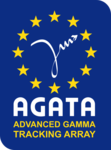Speaker
Description
Nuclei around N=60, Z=40 show a rapid variation in the deformation of their ground state with a rather small change in the neutron number. This feature manifests a subtle interplay between different aspects of the forces in the nucleus and makes this region an ideal testing ground for various nuclear structure theories. As an example, it is established that the ground state of Zr isotopes vary from nearly spherical for N<60 to well deformed after N=60 [1–4]. However, theoretical models do not agree on the shape evolution of Zr beyond N=60 [5–10].
Lifetime measurements in neutron rich isotopes are an effective way to shed light on the shape evolution in this region of the Segrè chart. For this purpose, a successful experiment was performed in 2017 at GANIL by using the AGATA array coupled to the VAMOS spectrometer. The fast timing array FATIMA and the Orsay Universal Plunger system was also installed, allowing lifetime measurements in the range of 1 ps to 1 ns. The data set obtained from this experiment contains hundreds of isotopes and is producing many new interesting results.
With this contribution we will present the actual status of the analysis of this experiment, with a brief overview of what as been already done, what is ongoing and which are the future expectations. The aim of the present analysis is to obtain reliable lifetime results and error estimations through a comprehensive application of the Differential Decay Curve Method for the measurement of the lifetime both in single gamma and in coincidence gamma-gamma. We will show preliminary lifetime results obtained after the improvement of the velocity resolution of the emitting nuclei from the VAMOS data.
[1] Sven A.E. Johansson, Nuclear Physics 64 (1) (1965) 147-160.
[2] E. Cheifetz, Phys. Rev. Lett. 25 (1) (1970) 38-43.
[3] D.A. Arseniev, A. Sobiczewski and V.G. Soloviev, Nuclear Physics A 139 (2) (1969) 269-276.
[4] R.K. Sheline, I. Ragnarsson and S.G. Nilsson, Physics Letters B 41 (2) 115-121.
[5] P. Moller et al., Atomic Data and Nuclear Data Tables 59 (2) (1995) 185-381.
[6] G.A. Lalazissis et al., Atomic Data and Nuclear Data Tables 71 (1) (1999) 1-40.
[7] J. Skalski et al., Nuclear Physics A 617 (3) (1997) 282-315.
[8] F. R. Xu et al., Phys. Rev. C 65 (2002) 021303.
[9] R. Rodríguez-Guzmán et al., Physics Letters B 691 (4) (2010) 202-207.
[10] J. Xiang et al., Nuclear Physics A 873 (2012) 1-16.

